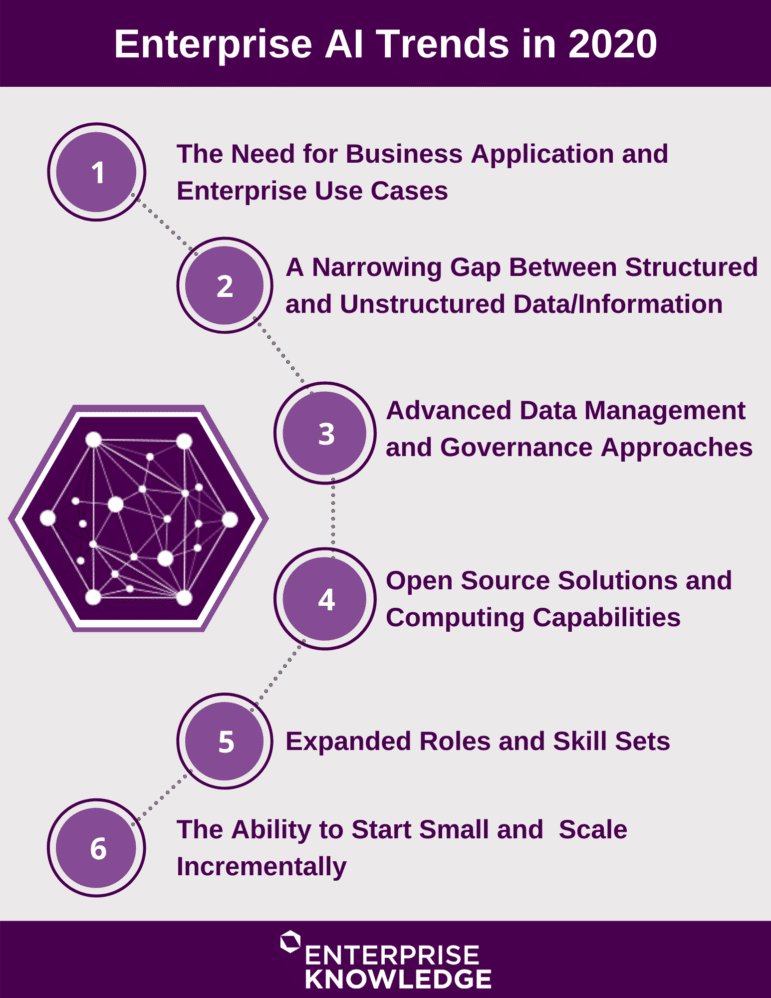Enterprise Artificial Intelligence (AI) entails leveraging machine capabilities to discover and deliver organizational knowledge and information in a way that closely aligns with how users look for and process information. The number of Enterprise AI applications is rapidly growing. Previously, I have defined the business drivers, foundational elements, and technical infrastructure necessary to make Enterprise AI initiatives a reality for any organization. Given our focus and experience in the knowledge, data, and information management space, we are recently seeing the following major trends in the scaling and implementation of Enterprise AI.

1. The Need for Business Application and Enterprise Use Cases
AI is no longer an experience, it is a business requirement that increasingly requires clear justification and tangible business values with return on investment (ROI) in order to receive funding and organizational support. Clear understanding of how advanced AI capabilities can impact business or help address relevant use cases is becoming the cornerstone for the success of Enterprise AI implementation and organizational alignment.
2. A Narrowing Gap Between Structured and Unstructured Data/Information
In the past, the academic debate on how we manage data vs. information vs. knowledge has been a central driver in determining how we practice these disciplines. Now, semantic solutions allow organizations to structure previously unstructured information by capturing meaningful relationships between data entities in a scalable and efficient manner. This makes it possible to train machines to interpret data in a human-centered way, powering knowledge and data discovery.
3. Advanced Data Management and Governance Approaches
There are more resources being dedicated toward Enterprise AI efforts to derive value from existing content and data, providing a better alternative to purchasing nebulous “big data” storages to glean a comprehensive picture of the data within the enterprise. By employing enterprise knowledge graphs, automated categorization, or a recommendation system, organizations can now achieve optimized access, natural language search, and use and re-use their information assets without a costly and burdensome migration.
4. Open Source Solutions and Computing Capabilities
Over the years, web standards, open source training models, and linked open data for a number of industries, such as open government data (OGD) or open science data, have emerged to help organizations craft customized Enterprise AI solutions for their business. This means an organization that is looking to start leveraging AI for their business no longer has to start from scratch. Further, Cloud computing capabilities have also progressed in a way that makes implementing these solutions a pragmatic and cost effective reality.
5. Expanded Roles and Skill Sets
Recently, there has been an increasing demand for individuals who have the technical skills to engineer advanced machine learning and intelligent solutions, as well as business knowledge experts who can transform data to a paradigm that aligns with how users and customers communicate knowledge. This is becoming achievable with growing skill sets in data science, knowledge engineering, and semantic architecture that facilitate unprecedented collaboration between knowledge and data across an organization.
6. The Ability to Start Small and Scale Incrementally
The most successful Enterprise AI initiatives are not attempting to incorporate every data set, every business unit, and every enterprise system. Organizations are more often building a rapid prototype or pilot, prioritizing a backlog of enhancements, and scaling iteratively.
These trends are key indicators that AI for the enterprise is no longer a hype, rather, it is becoming a necessity with feasible environmental and infrastructure support – now more than ever. If you are interested in how to benefit from your knowledge and data to accelerate enterprise AI capabilities, email us.
